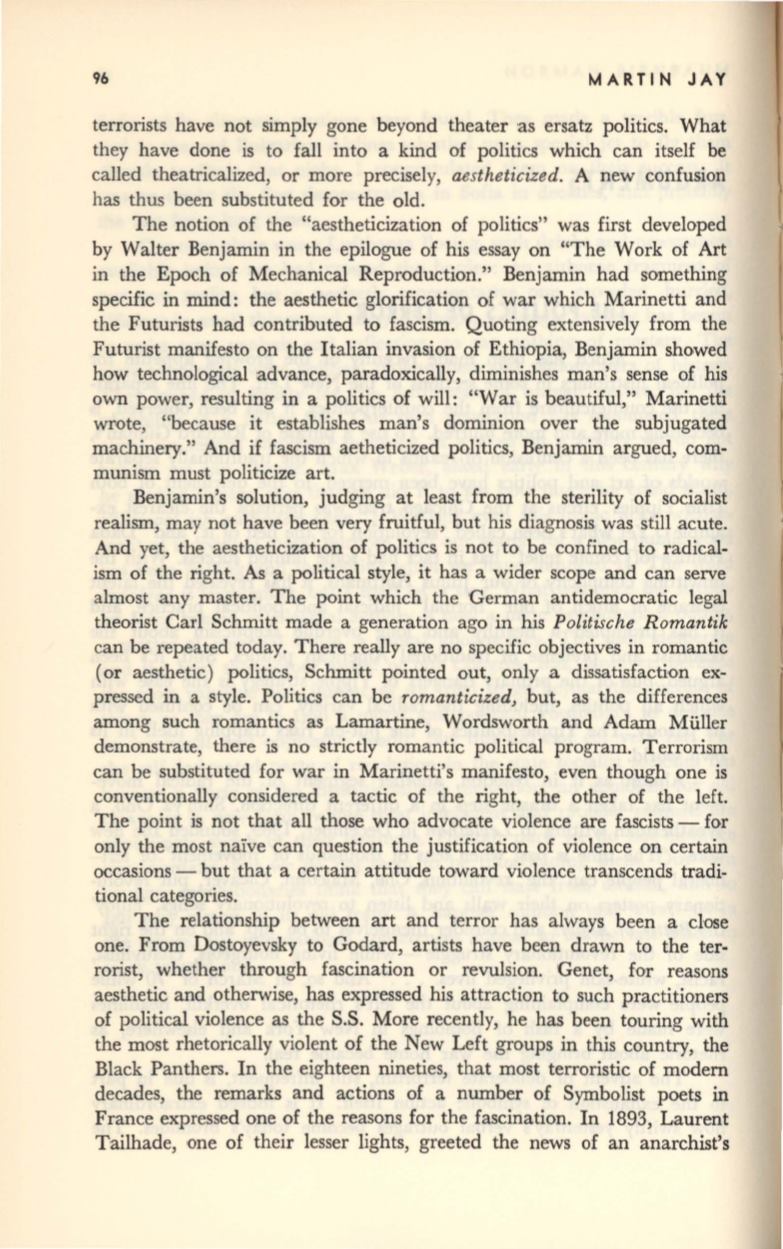
96
MARTIN JAY
terrorists have not simply gone beyond theater as ersatz politics. What
they have done is to fall into a kind of politics which can itself be
called theatricalized, or more precisely,
aestheticized.
A new confusion
has thus been substituted for the old.
The notion of the "aestheticization of politics" was first developed
by Walter Benjamin in the epilogue of his essay on "The Work of Art
in the Epoch of Mechanical Reproduction." Benjamin had something
specific in mind: the aesthetic glorification of war which Marinetti and
the Futurists had contributed to fascism. Quoting extensively from the
Futurist manifesto on the Italian invasion of Ethiopia, Benjamin showed
how technological advance, paradoxically, diminishes man's sense of his
own power, resulting in a politics of will: "War is beautiful," Marinetti
wrote, "because it establishes man's dominion over the subjugated
machinery." And if fascism aetheticized politics, Benjamin argued, com–
munism must politicize art.
Benjamin's solution, judging at least from the sterility of socialist
realism, may not have been very fruitful, but his diagnosis was still acute.
And yet, the aestheticization of politics is not to be confined to radical–
ism of the right. As a political style, it has a wider scope and can serve
almost any master. The point which the German antidemocratic legal
theorist Carl Schmitt made a generation ago in his
Politische Romantik
can be repeated today. There really are no specific objectives in romantic
(or aesthetic) politics, Schmitt pointed out, only a dissatisfaction ex–
pressed in a style. Politics can be
romanticized,
but, as the differences
among such romantics as Lamartine, Wordsworth and Adam Muller
demonstrate, there is no strictly romantic political program. Terrorism
can be substituted for war in Marinetti's manifesto, even though one is
conventionally considered a tactic of the right, the other of the left.
The point is not that all those who advocate violence are fascists - for
only the most naive can question the justification of violence on certain
occasions - but that a certain attitude toward violence transcends tradi–
tional categories.
The relationship between art and terror has always been a close
one. From Dostoyevsky to Godard, artists have been drawn to the ter–
rorist, whether through fascination or revulsion. Genet, for reasons
aesthetic and otherwise, has expressed his attraction to such practitioners
of political violence as the S.S. More recently, he has been touring with
the most rhetorically violent of the New Left groups in this country, the
Black Panthers. In the eighteen nineties, that most terroristic of modern
decades, the remarks and actions of a number of Symbolist poets in
France expressed one of the reasons for the fascination. In 1893, Laurent
Tailhade, one of their lesser lights, greeted the news of an anarchist's


